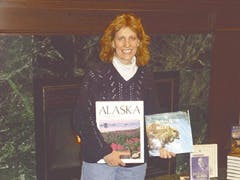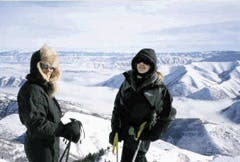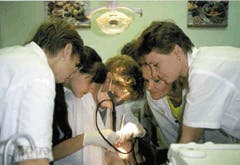An Alaskan adventure
Here`s an alternative practice setting that stretches from Lake Iliamna to Mother Russia.
Shirley Cross, RDH, BS
When my family moved to Anchorage a few years ago, I found myself in an unusual situation. I had practiced for 28 years and maintained licenses in only Oklahoma and Texas. I was shocked to learn that, in Alaska, I would have to retake the dental hygiene boards and go back to the University of Alaska in Anchorage to retake my local anesthesia course, even though I had given local anesthesia in Oklahoma for 13 years. I chose to go back to the university, because I had been informed that the boards were difficult and challenging and the time spent in the classroom would be well worth the effort. My instructor, Royann Royer, RDH, MPH, turned out to be not only a dedicated and well-organized educator, but she also became my friend. The more I got to know about Royann`s life in education, as well as in private practice, the more I wanted to share her many talents with RDH readers.
Living in Alaska is an adventure! There are challenges to dental hygienists who move to Alaska, and there are many opportunities that are open to hygienists who want to practice dental hygiene in alternative settings. Royann chose the course of her life in a most interesting way. She began as a certified dental assistant in Spokane, Washington, and then became certified in expanded functions. She then received her associate`s degree in dental hygiene from Clark College in Vancouver, Washington, in 1978. (She later obtained her bachelor`s degree in dental hygiene education and nutrition at Eastern Washington University in Cheney, Washington. Royann continued her education and received a master`s in public health from Loma Linda University in California in 1991.) She moved to Anchorage in 1983 and started teaching full-time at the University of Alaska in Anchorage in 1984.
Royann currently works as a dental hygienist at the Alaska Native Medical Center`s dental clinic in Anchorage. The new multi-million dollar state-of-the-art hospital opened in June 1997. Royann`s husband, Dr. Tom Kovaleski, was the administrator of the dental clinic until he stepped down from that position in 1998. He still works at the clinic but chooses to have more free time for other interests. Royann and her husband fly out to the bush in Alaska twice a year in a small airplane and treat mostly Native Alaskans of the Athabaskan culture in Iliamna at the New Halen school. They usually fly out in the fall around October and then again in the spring around April.
Dr. Tom, as he is affectionately called at the dental clinic, will take two or three dental assistants on his team. They see children from 9 a.m. to 3 p.m. and adults from 4 p.m. to 10 p.m. The team sets up its mobile clinic inside the school building, which houses grades 1-12. The team members all bring sleeping bags and sleep inside the school building. Royann stays a week and has seen the same patients for several years now. Dr. Tom stays for three weeks and will see patients in the surrounding villages around Lake Iliamna, where he does all types of general dentistry for children and adults. The lake is one of the two largest lakes in the world to have fresh-water seals. The other lake is Lake Baikal in Russia.
Royann`s main emphasis is on the children. During the day, she does many sealants, oral hygiene instruction, and fluoride treatments. She also does prophylaxis, root planing, and scaling with a Cavitron and hand instruments on adults in the evening hours. She has been going into the bush areas of Alaska for the last 10 years (Dr. Tom has been going for the last 15 years). In the past, Royann has traveled to the Pribilof Islands, which is in the Aleutian chain. She has also worked in Kotzebue, which is in northern Alaska, and in the village of Dillingham for five years in private practice, where she saw a combination of native people and non-natives.
Royann said of decay among the Native Alaskan population: "Soda pop is the most critical factor in decay in all of Alaska. The native population will drink canned soft drinks instead of water, and the villages will go through cases and cases of soft drinks in between my six month visits to their villages. Their diet today now contains a lot of processed foods and is much different from their diet in the past when they lived on fish and moose meat, as well as healthier fruits and vegetables that they grew themselves."
In 1984, Royann started teaching full time at the University of Alaska. She taught full-time for five years and now teaches part-time. When I took her local anesthesia course, I was impressed with Royann`s organization and her many supplemental videos and handouts on current technology in this field today. In addition to teaching, Royann has written a book with other Indian Health Service (IHS) educators called "Radiological Health and Safety." It will be published in 1999 and is an excellent study guide on radiology for IHS dental assistants to use in obtaining their certification in radiology. Royann let me peruse the final proof of this book, and it was well written and illustrated. It includes a written test following each chapter.
In 1997, she co-produced a professional video for dental hygienists called, "Achieving Successful Anesthesia." She worked with Susan Luetghe, RDH, MS, an associate professor at the university, and Dr. Bryson McBratney, a general dentist who has a private practice in Anchorage. Dr. McBratney supervises local anesthesia in the dental hygiene clinic at the school. I would like to add that the dental hygiene faculty includes Ellen Kazor, RDH, M/Ed, full professor and director of the dental hygiene program. They are the most wonderful people to work with, and they went over and above any of my expectations as a student.
In addition to these publications, Royann developed and wrote a module for the University of Kentucky titled, "Preventive Restorative Restorations," in 1996. Royann works part-time in the dental clinic at the Anchorage Native Medical Center, and she instructs an 88-hour course she developed called, "Introduction to Dental Assisting," for IHS dental assistants who work at the hospital. She also develops and presents many other continuing education courses for dental professionals through the university and the Alaska State Dental Hygiene Association. The most current course that she is involved in formulating is one on nitrous oxide, which recently has been approved for dental hygienists in Alaska.
From 1991-1995, Royann was a member of the Alaska State Dental Board, and, since then, she`s been involved with Western Regional Examining Board, working on several committees to update and improve the exams. She also has been an WREB examiner for six years and travels to many of the western states throughout the year. This has become a major part of her professional life. Some of her other accomplishments include being president of the Cook Inlet Dental Hygienists` Association from 1991-1995 and receiving the Alaska State Dental Hygiene Award for "Hygienist of the Year" in 1993. She holds membership in the ADHA, the International Dental Hygienists` Association, and is a member of the Institute for Circumpolar Health.
Besides her part-time work at the hospital in Anchorage, Royann has worked in private practice for Dr. Charles Michael since 1986. She also finds time to be a dental health education consultant/evaluator for the Head Start program in Alaska. She has worked with this program since 1988. Royann developed and produced six public service announcements on health education for broadcast on the Rural Access Network and KYUK, which serves viewers in more than 200 rural villages in Alaska. She received the 1991 National Award for Health Promotion and Disease Prevention from the Indian Health Service for the health education project.
Perhaps the most fascinating aspect of Royann`s educational abilities is taking place in Russia. Royann is a medical/dental team member of the Institute of Circumpolar Health, which has initiated expeditions into eastern Russia. Fifty people went on the first expedition in 1990 to evaluate what was needed as far as medical and dental services. The team members were hosted by Russian families during the two-week visit. At that time, the plans for a dental hygiene school in Magadan were started. The head stomatologist, as she is called in Russia (the equivalent of our dentist-director), of dental clinics throughout the city joined with the director of the nursing school in calling for a dental hygiene school.
Royann and other colleagues then traveled back and forth between Magadan and Anchorage on several trips. During these visits, the administrators evaluated resources and needs. The desire to proceed increased on both sides, and specific plans were proposed. Royann and Dr. Eric Spohn, a professor from the University of Kentucky, went to Magadan again in 1994 to help develop a curriculum for the Russian dental hygiene program.
The proposed school already has rooms available with some equipment, but the Russian educators lack two important elements before they can begin training dental hygienists in Russia. The first factor involves the necessary finances needed to successfully start the school. The second obstacle is bureaucratic in nature. The school needs permission from the central Russian government in Moscow. The profession of dental hygiene is not a part of the Russian system, so hygienists cannot be paid until the profession is approved by the government. However, a dental hygiene school in Murmansk, which began in September 1998 with 20 students, may expedite the profession`s status.
The Murmansk school received funding and equipment from Florida through the efforts of Tina Daniels, RDH, BS, and Julie Buckingham. Daniels is a professor of dental hygiene at Florida Community College in Jacksonville, while Julie Buckingham, past president of Jacksonville Sister Cities Association, is coordinator for the Dental Hygiene Project in Russia. Tina said Murmansk was chosen as a sister city since both are seaport cities with naval bases.
"Royann was so supportive to me throughout this whole adventure of trying to get a dental hygiene school started," Tina said. "I cannot tell you how much her support meant to me. I could e-mail her anytime about a hurdle. She would reply to my e-mail and help me find an answer or point me in the right direction."
In addition to developing the curriculum in Magadan, Royann has flown to Khabarovsk on three other occasions - twice for the Catholic Relief Services. CRS developed a curriculum for elementary children in grades 1 through 6. She helped translate the ADA oral health books (now out of print) for teachers into Russian so that the teachers could instruct students about oral health. The graphics were also changed to complement the Russian culture. The books have been well received by the teachers.
Since August 1994, she has lectured to a group of teachers in the elementary schools before classes begin each September. She discusses and demonstrates oral health techniques to teachers so that they, in turn, can teach students.
The other aspect of her trips to Khabarovsk has been teaching oral hygiene procedures to Russian nurses who have no knowledge of dental care. Royann does intensive training for six days a week, eight to 10 hours a day, and teaches the nurses about disclosing solution, oral hygiene instructions, sealant application, and minimal use of sickle and universal scalers. On each of her three trips to Khabarovsk, Royann has trained six nurses who then practice as pediatric oral health practitioners in children`s dental clinics. The nurses, in turn, become mentors and begin initial training for other nurses when she is not in Russia. There are now three dental hygiene clinics for children in Khabarovsk, which are funded by the Khabarovsk government with paid services - a new concept in Russia.
"It is so rewarding to see how the children have grown in not fearing dental treatment like they did when I first flew into Russia to help educate the teachers and nurses," Royann said.
She said, "My last trip into Russia was in August 1998. I stayed in my own apartment, which made me feel like a real Russian citizen. I had several doors and many locks that I had to go through in order to get inside my apartment. People do not feel as safe as they did previously, with all the problems that have occurred in Russia these past few years." However, Royann did not experience any problems, and she considers it to be a very good experience to live in a real neighborhood in Russia. Royann still wants to see a dental hygiene school in operation in far eastern Russia as soon as possible.
Catholic Relief Services no longer has a center in Khabarovsk. On her August 1998 trip, Royann volunteered for the Citizens for Democracy Corps, a nonprofit organization in Washington, D.C. They paid for her flight to Russia. The dental clinic in Khabarovsk paid for her apartment, but Royann donated her services for two weeks to help educate the nurses. During this trip, Royann had two meetings with the dean of the dental school, and the prospects look promising for a dental hygiene program to begin soon in the University of Khabarovsk Dental School.
Royann`s interpreter for the past three trips has been Vera Koreshova, a Russian dentist. She flew over from Russia to Anchorage and stayed for two months in order to learn about dental hygiene and periodontal techniques from the clinicians at the Alaska Native Medical Center Dental Clinic. She is now in graduate school in periodontics and will be one of the first periodontists in Russia.
Russian dentists usually go to school for eight years. The first six years are all didactics, and, during the last two years, they go to different clinics and work with patients under the supervision of a staff of dentists.
As you can see, Royann`s passion is definitely in education. I have had the opportunity to learn from her, not only in the classroom, but also by observing her excellent clinical skills as I volunteered at the Alaska Native Medical Center dental clinic. Royann has a gift for not only educating students but also for educating her patients. She develops a rapport quickly with her patients, because she listens and then assesses their needs.
As for her personal life, Royann married Dr. Tom in 1995. She met him while teaching at the UAA in 1988. Dr. Tom was one of the supervising dentists. As Dr. Tom thinks about retirement, he has started expanding his horizons. Two years ago, he opened up a dental clinic for an orphanage in Vietnam with another IHS dentist. The couple would love to do more international volunteer dentistry. Royann has a 13-year-old daughter, Michala, and the entire family loves to cross-country and downhill ski. They also enjoy rafting, camping, and traveling. They travel to Mexico once a year.
Every May, since Michala was five years old, she and Royann have entered the Gold Nugget Triathalon. This includes a 5K run, a 1500-meter swim, and a 13-mile bike ride. Royann has organized the "Miles for Smiles" dental hygiene run here in Anchorage for the last three years. This includes both a 10K and a 5K run, and it takes place in September to help promote National Dental Hygiene Month in October.
It has been my pleasure to introduce you to Royann Royer, who is a dynamic educator as well as a busy and organized wife, mother, friend, and clinician here in Alaska. The opportunities for our dental hygiene profession are numerous, and what fun it is to learn about hygienists who practice not only in private practice, but also in other nontraditional settings. From the Alaska bush area with its native villages to the countries of Russia and Vietnam, Royann and her family have definitely made an impact in the dental and dental hygiene fields. What a joy it has been for me to become a student again and get to learn from one of the most passionate and dedicated teachers in the classroom. If any readers want more information on any of Royann`s publications or local anesthesia video, she can be contacted at Innovative Dental Education, P. O. Box 671574, Chugiak, AK 99567, or by e-mail at [email protected].
Shirley Cross, RDH, BS, graduated from the Caruth School of Dental Hygiene in Dallas in 1969. She currently resides in Anchorage, Alaska. Readers can contact her at [email protected].
Royann Royer
Royer and daughter, Michala, prepare to ski Alaskan style.
Royer demonstrates ultrasonic scaler to Russian students.
A well traveled family: Michala, Royann, and Dr. Tom Kovaleski




